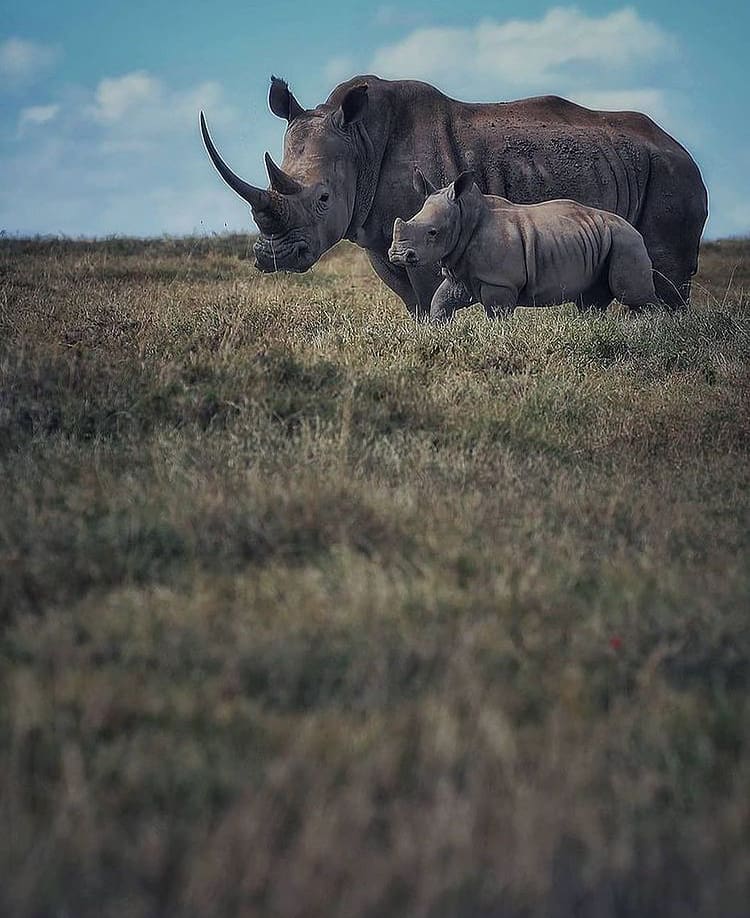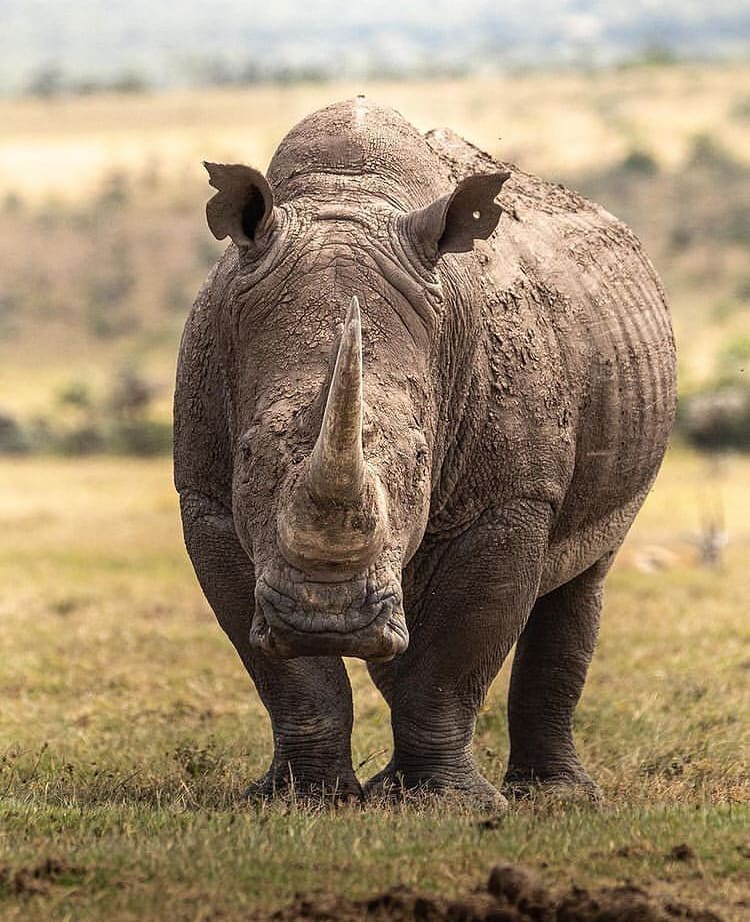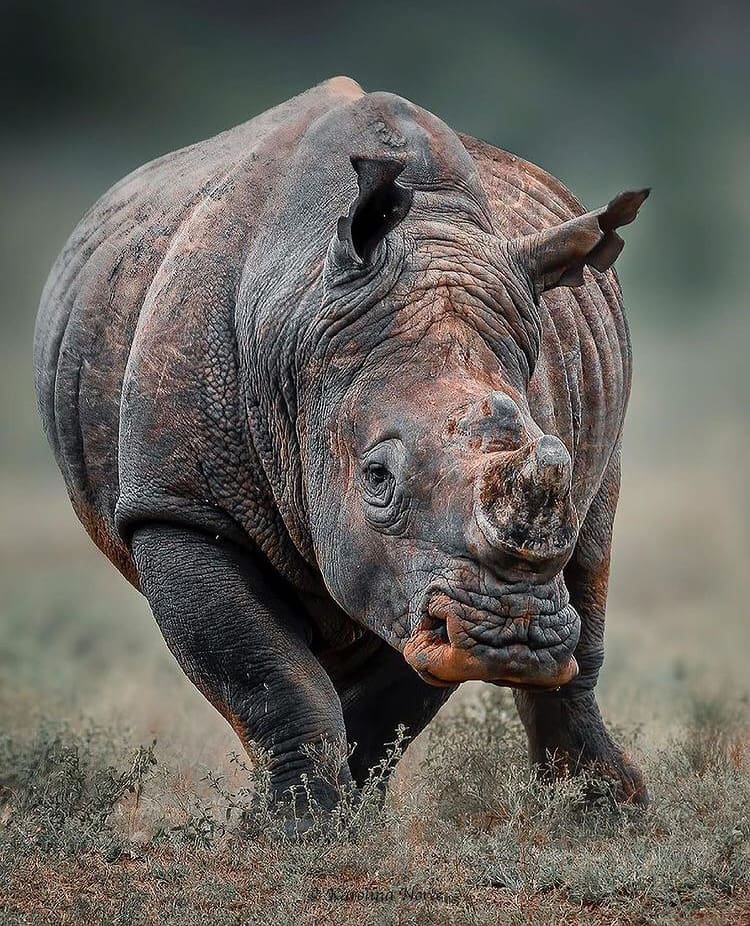[social_warfare]
One of the most persecuted animals of the modern era, the white rhino is a highly publicized and easily recognizable species.
They possess an incredible set of horns, and boast an overall prehistoric look. Quite appropriate for one of the oldest species on earth.
What is the White Rhino?
The white rhino is the world’s second largest land mammal, after the elephant. They are one of Africa’s Big Five animals and are highly sought-after among safari goers who flock to catch a glimpse of these incredible animals.
They are also know as the square-lipped rhino because of their (you guessed it!) square lips. Their are two subspecies, the northern white rhino and the southern white rhino.

White Rhino vs Black Rhino
Contrary to what the name suggests, there is no colour differential between white and black rhinos. Instead the two subspecies are separated in appearance by their size, facial structure.
So why is it called the White Rhino?
The name ‘white rhino’ came from the mispronunciation of the Dutch word ‘wijd’ which means wide. This initial phrase was used in reference to the species’ wide lips.
Appearance
How big is the White Rhino?
A white rhino’s outline is characterised by a distinctive hump of impressive neck muscles used to support their large heads. Their head hangs down, never far from the ground. They will only lift their heads when startled and only have limited ability to do so.

White rhinos are the largest of all rhino species and cut an impressive figure. A mature bull stands at around 6ft. (1.85m) at the shoulder, while females are usually slightly shorter and around 5ft. (1.5m). From head to tail they average between 10 and 15ft (3-5m) long.
Rhinos are solidly built, stocky animals and resemble a grey, fleshy tank as they move through the bush. Adults weigh between 4,000 and 8,000 lbs (1,800-3,500kg) on average, with a very large head, a muscular neck and a broad chest. New born calves weigh between 90 and 140 lbs. (40-60kg) at birth.
White Rhino Skin
Despite their name, there is no colour difference between the white and black rhino. Both species have thick brownish-grey skin that covers their entire body. Their skin ranges between 1.5 and 5cm thick and is made from layers of collagen. Rhinos have three hooved toes, and surprisingly small legs for such large animals.
How big are White Rhino horns?
The White Rhino has two distinctive horns on the end of their nose. The front horn is much larger than the inner, and can grow upwards of 3ft. (1m) long. Rhino horns are made form keratin, similar to human fingernails and hair. Babies are born without a horn, which will grow continually throughout the animal’s life.

White Rhino Lips
One of the white Rhinos most distinctive features when compared to the black rhino is its upper lip. White rhinos have wide, flat, square-shaped lips which they use to pull grasses and shrubs out of the ground.
Behaviour
What do White Rhino’s eat?
White rhinos are grazers, which means they feed from the ground rather than from bushes or trees. They are herbivores, and their diet consists of grasses, leaves, shrubs, roots, herbs and the occasional wild vegetable. Their flat upper-lip allows them to get really close to the ground where they can even eat grasses that are just 1m min length. An adult white rhino can eat upwards of 120lbs (50kg) of food per day, most of which is not digested but simply passes straight through. Thus, a rhino’s dung is extremely ‘grassy’ in texture.

Rhinos move slowly through the bush, constantly grazing as they go. Their large, heavy heads are always neat to the ground and only lifted when they sense a threat. They spend most of the day feeding, and the balance of it resting.
They’ll usually spend the hottest part of the day resting in a shady spot, or wallowing in the mud. While doing so, they will fully cover themselves in mud as a means of protection against the sun, and to suffocate parasites they take hold of their skin.
In drier areas, rhinos will still wallow in the dry sand and cover themselves with dust.
White Rhino Social Structure
White rhinos are generally solitary animals, however females are rarely alone. Most often they live in pairs, either with their calves or with a similarly aged companion. Calves stay with their mothers until around three years old, when they’re mature enough to care for themselves.

Family groups called ‘crashes’ are commonly seen with 5 or 6 individuals living together, although this is sadly becoming less frequent.
Are White Rhino’s Territorial?
A white rhino bull’s territory is surprisingly small, only around 1 to 2 square miles (1-3sq km) on average. Although this does vary, and is largely dependant on the quality food and water sources in the area.
Territory is half by a dominant bull who allows the presence of a few ‘satellite bulls’. These are nomads who claim no territory and are accepted as long as they act submissively.

Dominant bulls are a lot more aggressive towards foreign males who may challenge for their territory. Rhinos are incredibly unpredictable and gorey fights are not uncommon.
Territories are marked with sprayed urine and dung piles dropped along its border. These ‘rhino middens’ are very commonly seen along roads in national parks, as rhinos have become accustomed to using roads a territorial border.
Females are not as territorial as males, and generally live in a ‘home range’ more than a specific territory. These can range between 3 and 12 square miles (5 – 20 sq. km), and may overlap sever male territories.
Habitat & Range
White rhinos prefer savanna grasslands and open woodlands as these provide them with their ideal food sources, and allow them to move around with ease. They tend to stick to flatter terrains, near a water source.
Rhinos are found in various countries in Africa, however the vast majority of these live in sub-Saharan Africa.

South Africa, Zimbabwe, Namibia and Kenya host the most plentiful populations, with 98.8% of the total population living in these four countries. All of which are found in bordered or fenced off national parks and reserves.
Various conservation efforts are seeing white rhinos being re-introduced into other parts of Africa, with various degrees of success.
Conservation
How many white rhinos are there in the wild?
The white rhino is one of the more prevalent rhino species in the world, however their population is still on a steady decline. Today the majority of southern white rhinos are found in South Africa and Kenya, while the northern white rhino is functionally extinct.
Recent surveys suggest there are currently around 20,000 white rhinos in Africa.

Is the white rhino endangered?
The white rhino is listed as ‘Near Threatened’ on the IUCN red list. This means the population is not facing an imminent threat of extinction, however the species is still at risk of sliding further towards extinction.
Threats to white rhinos in Africa
In a world where most species are at risk of habitat loss, the biggest threat to white rhinos in Africa is poaching.
Poachers stalk and slaughter rhinos with the aim of stealing their horns, which fetch extortionate prices on the black market in Asia. Rhino populations across the world have been under constant persecution for decades because of this.
In conjunction with this, habitat loss and human encroachment are also very real threats facing white rhinos in Africa as the human population continues to grow and develop.

Safari
The best places to see white rhinos while on safari in Africa are game reserves and national parks in the southern and eastern regions of the continent.
Most of these offer guided safaris led by knowledgeable game rangers, self-drive safari facilities or a combination of both.
Rhino sightings are generally the best in South Africa, Zimbabwe, Namibia and Kenya, where populations have been best protected against poaching.
Here are some of the best places to visit if you’re hoping to see white rhinos in the wild:
- Kruger National Park, South Africa
- Ol Pejeta Conservancy, Kenya
- Hluhluwe-iMfolozi Park, South Africa
- Masai Mara National Reserve, Kenya
- Etosha National Park, Namibia
- Ngorongoro Crater, Tanzania

Facts about the white rhino
- Scientific name – The scientific name for the white rhino is Ceratotherium simum.
- Eyesight – White rhinos have very bad eyesight and are unable to see a motionless object at a distance of 30 metres or more.
- Smell & Hearing – To make up for their poor vision, white rhinos have an incredibly well-developed sense of smell and hearing. This is what they use to navigate their way through the bush, and to recognise potential threats.
- Nostrils – White rhinos have the widest set nostrils of any land mammal on earth.
- Limited Mobility – Due to their very large neck muscles, white rhinos have very little range of motion when it comes to lifting their heads. Drownings have been recorded in very shallow ponds, as the rhino was unable to lift its head out the water.
- Death rate – A rhino is poached in Africa every 22 hours.
Myths about the white rhino
- Speed – Despite their massive bulk, white rhinos are incredibly fast animals. Over short distances they can reach up to 31mph (50km/h).
- Horns – Rhino horns are not true horns that grow from the skull. Instead they are made of keratin which grows directly from the skin, much like our finger nails and hair.
- Horns Are Medicinal – In parts of Asia it is believed that rhino horns have medicinal properties, or are an aphrodisiac. This is entirely false and the horns have no beneficial makeup whatsoever.
- Ivory – A common misconception is that white rhino horns are made from ivory, like elephant tusks. However, as mentioned above, this is untrue and rhino horns are 100% keratin.
- Northern white rhinos are extinct – Despite very wide scale publicity, northern white rhinos are not actually extinct – yet. At present there are two northern white rhinos living in captivity, however these are both female so it’s only a matter of time unfortunately.
- White – White rhinos are not white despite what their name might suggest. Instead their skin is a brownish grey colour, similar to that of the black rhino.
Cover Image © Jaydeep Patil (@jaydeeppatilphotography)
